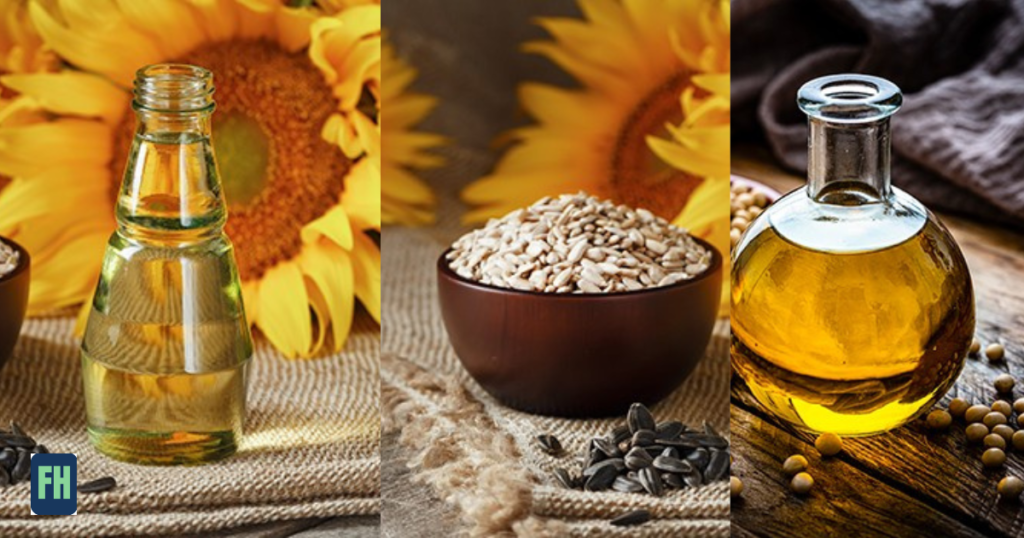You’ve probably heard whispers online: “Seed oils are toxic!” or “They’re secretly making us sick!” But what’s the real story? Let’s cut through the noise and explore what seed oils are, how they’re used, and whether they deserve their bad reputation.

Which seeds are used for This oil?
Seed oils are exactly what they sound like—oils extracted from the seeds of plants. The most common ones, often dubbed the “hateful eight,” include:
- Canola (rapeseed)
- Sunflower
- Soybean
- Cottonseed
- Corn
- Grapeseed
- Rice bran
- Safflower
These oils are rich in unsaturated fats, particularly omega-6 fatty acids like linoleic acid, which plays a role in everything from brain function to skin health. But their reputation has taken a hit lately, with critics blaming them for inflammation and chronic diseases. So, what’s the truth?
How Are Seed Oils Made?
Most seed oils are produced through mechanical pressing (crushing seeds to release oil) or chemical extraction using solvents like hexane. While mechanical methods preserve nutrients and flavor, large-scale production often relies on chemical processes. Critics argue these methods leave behind toxins, but regulatory agencies ensure residual chemicals are removed to safe levels before oils hit store shelves.
The bigger concern? Reusing oils at high temperatures, like in fast-food fryers. When overheated repeatedly, oils can break down into harmful compounds. But cooking with seed oils at home? Not an issue if you’re not burning them.
Why Are Seed Oils Everywhere?
Over the past 50 years, seed oils have become staples in the American diet—and not just in your kitchen cabinet. They’re hidden in:
- Ultra-processed snacks (chips, crackers, cookies)
- Fast food (used for frying)
- Vegan alternatives (plant-based meats, dressings)
- Margarine and spreads
Today, a staggering 57% of adults’ daily calories come from ultra-processed foods (UPFs), which rely heavily on seed oils. This shift has spiked our omega-6 intake, raising questions about balance.
The Omega-6 Debate: Friend or Foe?
Omega-6s, like linoleic acid, are essential fats your body can’t make on its own. They help regulate metabolism and support cell function. However, some studies suggest that excess omega-6 (without enough omega-3s from fish, walnuts, or flaxseeds) might promote inflammation—a driver of chronic diseases.
But here’s the twist: Recent research tells a different story. A study of 70,000 people found higher linoleic acid intake linked to a lower risk of heart disease. Another linked it to reduced type 2 diabetes risk. The key takeaway? It’s about balance, not demonizing one nutrient.
Do Seed Oil Cause Diabetes or Heart Disease?
Critics often blame seed oils for America’s rising diabetes rates. Yet evidence doesn’t back this up. Polyunsaturated fats (like omega-6s) actually improve cholesterol levels and blood sugar control. The real villains? The sugary, salty, ultra-processed foods that contain seed oils.
For example, fries from a fast-food joint aren’t harmful just because they’re fried in soybean oil—it’s the combo of excess calories, refined carbs, and lack of nutrients that’s the problem.
7 – Day Beginners Diabetes meal plans
The Bottom Line: Should You Ditch Seed Oils?
No—but be mindful. Seed oils themselves aren’t toxic, and they’re cost-effective for cooking. However:
- Prioritize whole foods: Reduce UPFs (packaged snacks, frozen meals) where seed oils lurk.
- Balance fats: Pair omega-6-rich oils with omega-3 sources (salmon, chia seeds).
- Cook smart: Avoid overheating oils. Use avocado or olive oil for high-heat cooking.
Moderation is key. Swapping seed oils for butter or coconut oil everywhere isn’t healthier—it’s about the bigger picture of your diet.
Keto Diet Advantages and Disadvantages: Is It Right for You?
Final Thought
Seed oils aren’t the dietary supervillains they’re made out to be. While overdoing ultra-processed foods harms health, the oils themselves can fit into a balanced diet. Focus on eating more whole foods, diversify your fats, and save the deep-fried treats for occasional indulgences. Your body (and taste buds) will thank you!